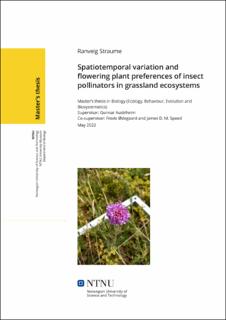| dc.contributor.advisor | Austrheim, Gunnar | |
| dc.contributor.advisor | Ødegaard, Frøde | |
| dc.contributor.advisor | Speed, James D. M | |
| dc.contributor.author | Straume, Ranveig | |
| dc.date.accessioned | 2022-07-09T17:22:31Z | |
| dc.date.available | 2022-07-09T17:22:31Z | |
| dc.date.issued | 2022 | |
| dc.identifier | no.ntnu:inspera:104135638:23319027 | |
| dc.identifier.uri | https://hdl.handle.net/11250/3004409 | |
| dc.description.abstract | Pollinatorer er viktige i de fleste terrestriske økosystemer og deres nåværende tilbakegang er av stor bekymring. De store, naturlige svingningene til insektpollinatorene mellom år gjør det vanskelig å studere trendene deres via korttidsstudier alene. Det er derfor et sterkt behov for flere langvarige og kontinuerlige studier, samt økt kunnskap om pollinatorenes romlige og temporale variasjon. Endt skjøtsel av semi-naturlige gressletter, et viktig habitat for mange pollinatorer, medfører suksesjon av gresslettene som slik blir til suksesjonsgressletter, et habitat ofte sett på som mindre ideelt for de fleste pollinatorer. Kunnskap om pollinatorene i semi-naturlige- og suksesjonsgressletter, samt konkret data på hvilke blomsterplanter pollinatorene foretrekker i de to habitattypene er nyttig kunnskap for fremtidig konserveringsarbeid. I dette studiet undersøkte jeg: (1) den romlige og temporale trenden for humler og dagsommerfugler i gressletter på en regional skala over ni år, (2) antallet pollinatorer samt pollinator artsrikdommen i semi-naturlige- og suksesjonsgressletter over to år på en lokal skala, og (3) blomsterplantepreferansen til pollinatorer, her primært humler, i semi-naturlige- og suksesjonsgressletter på en lokal skala. Data samlet inn på en regional (Trøndelag fylke, Norge) og en lokal (Trondheim, en kommune i Trøndelag) skala ble brukt i dette studiet.
Artsrikdommen, artssammensetningen og antallet individer observert for humler og dagsommerfugler var signifikant forskjellig mellom de regionale studieområdene. Dette er trolig på grunn av forskjeller i områdenes egnethet som habitater for pollinatorene. Humlene i det regionale studiet hadde en stabil trend over årene med en tilsynelatende uendret artssammensetning. Sommerfuglene hadde en positiv trend der enkelte arter, slik som Aglais urticae and Pieris napi, har blitt mer tallrike. Ingen signifikant forskjell mellom de to typene gressletter be funnet for pollinatorene i det lokale studiet selv om artsrikdommen til blomsterplantene og antallet blomsterplanter observert var signifikant høyere i de semi- naturlige gresslettene. Humlene i det lokale studiet viste tydelige preferanser for enkelte blomsterplantearter. De besøkte primært Knautia arvensis i de semi-naturlige gresslettene, og Epilobium angustifolium i suksesjonsgresslettene. De besøkte generelt flere plantearter i de semi-naturlige gresslettene. Den store nedgangen i pollinatorer observert globalt ble ikke funnet i dette studiet. Dette kan være grunnet klimaendringer som har ført til bedre forhold for dagsommerfuglene i denne regionen, og tidligere humle tap som har resultert i mest motstandsdyktige generalister i de gjenværende samfunnene. Fremtidige langtidsstudier bør inkludere detaljert værdata når pollinatorenes variasjon mellom år undersøkes. Dynamikken rundt pollinatorenes blomstervalg bør studeres videre. | |
| dc.description.abstract | Pollinators are crucial members of most terrestrial ecosystems, and their current declines are of great concern. Large, natural fluctuations of insect pollinators among years make their trends difficult to study with short term surveys alone. Long term, continued research is therefore needed, along with increased knowledge on the spatiotemporal trends of these pollinators. The abandonment of semi-natural grasslands, an important habitat for many pollinators, results in the grasslands undergoing succession and becoming successional grasslands, a habitat type often considered less ideal for many pollinators. Increased knowledge on the pollinators in both semi-natural and successional grasslands and concrete data on the pollinators flowering plant preferences in these land-use systems may be important knowledge for future conservation efforts. In this study I examined: (1) spatiotemporal trends of bumblebees and butterflies in grasslands at a regional scale over a nine-year period, (2) pollinator abundance and species richness in semi-natural and successional grasslands over two years at a local scale, and (3) flowering plant preferences of pollinators, primarily bumblebees, in semi-natural and successional grasslands on a local scale. Surveys conducted at a regional (Trøndelag county, Norway) and local (Trondheim, a municipality in Trøndelag) scale was used in this study.
The bumblebee and butterfly abundance, species richness, and species composition were significantly different across the regional sites. This was likely caused by differences in habitat quality among the sites. Of the regional survey, the bumblebees had a stable trend over the years with a seemingly consistent species composition, while the butterflies had a positive trend with species such as Aglais urticae and Pieris napi becoming more abundant. No significant effect of land use was identified for the pollinators of the local survey, although the floral abundance and plant species richness were significantly higher in the semi-natural grasslands. The bumblebees of the local survey exhibited clear flowering plant preferences. They primarily visited Knautia arvensis in the semi-natural grasslands and Epilobium angustifolium in the successional grasslands and interacted with more flowering plant species in the semi-natural grasslands. The great pollinator declines that have been observed globally were not detected in this study. This may be due to the warming climate improving the conditions for butterflies in this region and past bumblebee declines causing present-day species compositions to consist of more generalist species resistant to change. Future long-term studies should incorporate more detailed climatic data when addressing the pollinator variations among years, and the dynamics of flower choice among pollinators should be studied further. | |
| dc.language | eng | |
| dc.publisher | NTNU | |
| dc.title | Spatiotemporal variation and flowering plant preferences of insect pollinators in grassland ecosystems | |
| dc.type | Master thesis | |
